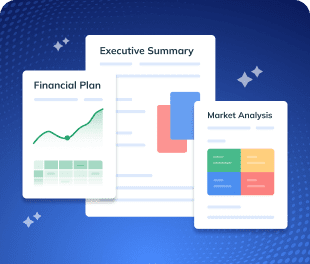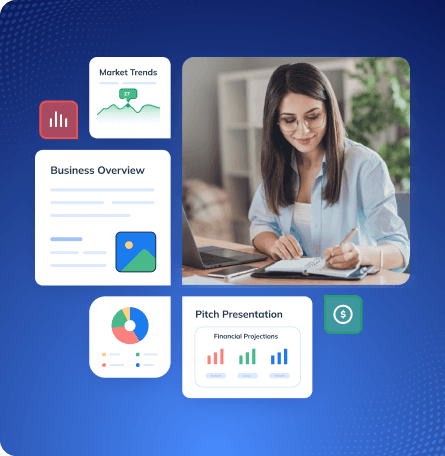You’ve got the land, the barn, and a real love for horses. Maybe you’ve already been boarding a few, helping out friends, and now you’re ready to turn that into something more official.
But running a horse boarding business isn’t just about full hay nets and clean stalls. It’s about daily routines, client expectations, vet calls, unpredictable weather, paperwork, and trying to make it all add up at the end of the month.
So, you’ll need a solid business plan to help you think through everything from services and pricing to operations and growth.
Never written one before?
No problem! This horse boarding business plan template is here to walk you through the process!
Why do you need a business plan for a horse boarding facility?
Before understanding how to draft a business plan for a horse boarding facility, it’s important to check out a few compelling reasons why you need one. Here’s why a business plan matters:
Clarifies your business model
A business plan helps you decide what type of boarding services you’ll offer—full board, pasture board, self-care—and how you’ll price them. It outlines the scope of your operations and the kind of clients you want to attract.
Helps estimate costs and income
From feed and labor to insurance and equipment, your plan breaks down all the expenses. It also projects your income based on stall capacity and service pricing, so you know what it takes to stay profitable.
Supports funding and financing
If you’re applying for a loan or seeking financing, lenders and investors will want to see a clear business plan. It shows them you’ve done your homework and you’re not just guessing—you’re prepared.
Organizes day-to-day operations
A well-written plan outlines how your facility will run daily—who takes care of what, what routines are in place, how emergencies will be handled, and how client communication will be managed.
Builds trust with clients and partners
A structured plan signals professionalism. Whether you’re working with a vet, hiring staff, or attracting boarders, it shows that your facility is well thought out and dependable.
In short, a business plan turns your idea into action—and helps you make informed decisions, avoid costly mistakes, and build a facility that’s not just functional but thriving.
How to draft a solid horse boarding business plan?
Follow these steps to draft a solid horse boarding business plan from scratch:
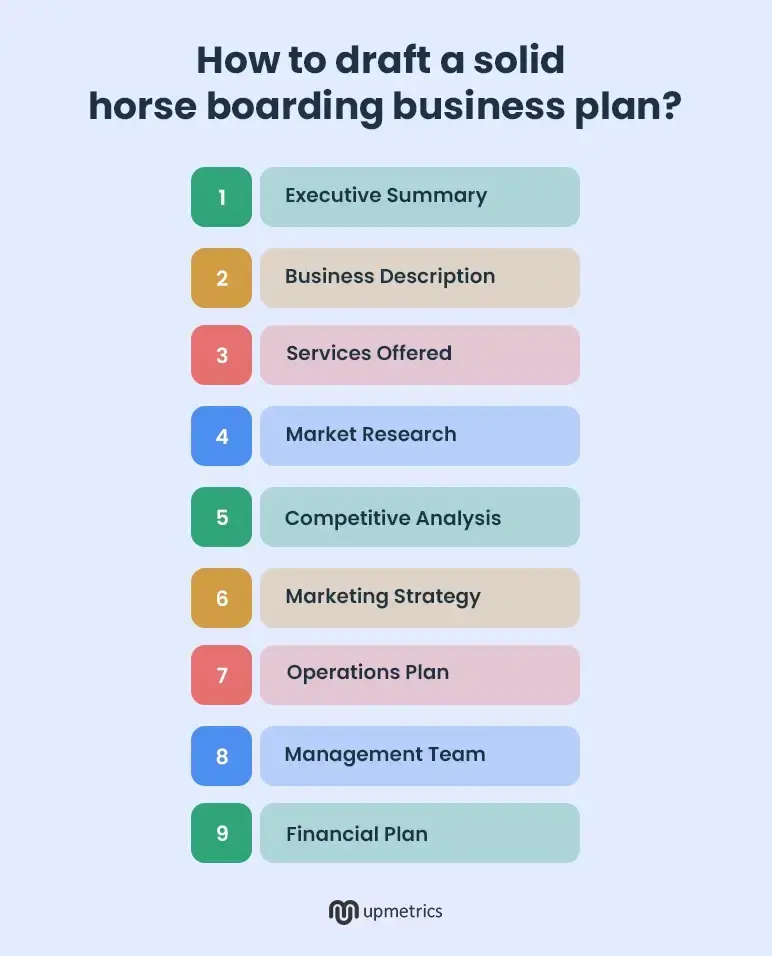
1. Executive Summary
The executive summary gives a brief overview of what your horse boarding facility is all about. It highlights what you offer, who you serve, what makes you stand out, and where you’re headed.
As it’s the first section your potential investors or partners read, it should give a clear and compelling overview of your whole business plan. So, it’s a good idea to write it after you’ve finished the full plan. That way, you’ll know exactly which information to include and what to omit.
Here’s what you need to cover in this section:
- Business name and location
- Brief description of your services
- Vision and mission statements
- Target market
- Financial snapshot
- Business goals
Try to stick to a maximum length of a page and keep your plan summary simple yet engaging. After all, you wouldn’t want potential investors to get bored before diving into the plan.
Say goodbye to boring templates
Build your business plan faster and easier with AI
Plans starting from $14/month

2. Business Description
This section clearly describes who you are, what you do, and where your horse boarding facility is headed.
Start by stating your business structure—whether you’re a sole proprietorship, LLC, or partnership—and include your setup (owned land, leased stables, or a custom-built facility).
Mention your right business location, service area, and any animal care or safety standards you plan to meet, including local agricultural or equine welfare regulations.
Then, briefly describe the core services of your business. Are you offering full-service boarding with daily turnout and grooming? Self-care options for experienced owners? Define what sets your facility apart—like personalized attention, top-notch amenities, or a peaceful rural setting.
If applicable, add a short backstory—why you started this facility and the gap you’re filling. Maybe you saw a need for more dependable horse care in your region. Or perhaps your passion for your own horses turned into a plan.
Lastly, don’t forget to highlight your vision and mission statements that define your purpose and long-term goals. For example:
Vision Statement
“To be the region’s most trusted and welcoming home for horses—where quality care, safety, and peace of mind come first.”
Mission Statement
“We provide compassionate, reliable, and professional horse boarding services tailored to the unique needs of each horse and owner. Through well-maintained facilities, experienced staff, and a commitment to welfare, we help horses thrive and owners rest easy.”
3. Services Offered
Here’s where you break down what your horse boarding facility actually provides. “Horse boarding” can mean different things to different audiences, so it’s important to be clear and specific.
Are you offering a full board with daily care included? Do you allow owners to manage their feeding and turnout? What extras do you provide that make your facility stand out?
This section helps investors understand exactly what services you offer—and how those services meet the real needs of horse owners.
Here are a few key elements to include in this section:
- Core services
- Value-added services
- Service delivery model
- Special focus
- Pricing strategy
The more clearly your services are outlined, the easier it is for your ideal audience to see the value and for partners and investors to see the potential.
4. Market Research
Before you open your horse boarding facility, it’s important to conduct thorough market research. This will help you prove that there’s a real demand for your services, not just a gut feeling.
A strong market analysis shows lenders, investors, or partners that you understand the horse boarding industry and that your business fills a clear need.
The following are a few key elements that you should cover in the market analysis section:
Industry Size and Growth Potential
Start with a quick overview of the horse boarding industry. How big is it in your area or state? Are there more horse ownership patterns? Is land for private horse care becoming limited?
Explain why now is a good time to start a boarding facility—maybe there’s growth in recreational horseback riding lessons or an increase in local equestrian events.
Target Customers
Describe who your potential customers are. Break them down into a few customer segments and describe both their basic traits (like age, income, and lifestyle) and what they care about when choosing a boarding facility. For instance:
| Group | Who They Are (Demographic) | What They Care About (Psychographic) |
|---|---|---|
| Competitive Riders | Ages 18–40, active in local show circuits | Need structured care, access to trainers, performance focus |
| Recreational Owners | Ages 25–60, own 1–2 horses for pleasure | Want a stress-free, affordable boarding option |
| Retired Horse Owners | Ages 50+ , no longer ride, but own horses | Seek trustworthy long-term care for older horses |
| Parents with Young Riders | Local families, mid-income | Look for safe environments and lesson options |
Recent Trends
Lastly, discuss what’s currently popular or changing in the horse boarding industry.
Are more owners looking for eco-friendly horse training facilities? Are short-term or seasonal boarding options becoming more common?
Also, highlight how you plan to respond to these trends. This shows you’re building a business that’s current and relevant.
Overall, a thorough market research shows you’re serious, informed, and building a horse boarding facility that meets real needs, not just your dream. Hence, keep this section practical, grounded, and focused on what your clients want.
5. Competitive Analysis
The competitive analysis section is all about identifying and analyzing the other horse boarding options and alternatives available around you. So, consider both direct and indirect competitors and explain how your business can stand out.
Your direct competitors could be the nearby horse boarding stables or centers offering similar services. Indirect competitors might include private landowners who rent out pasture space or even horseback riding clubs with limited boarding spots.
Here’s how to approach your competitive analysis:
Step 1: Research what each facility provides. Take note of where your services align—and more importantly, where they differ.
Step 2: Compare your competitors’ pricing models. Also, take a close look at reviews or testimonials. This helps you understand what customers value most and what gaps may exist.
Step 3: Figure out who your competitors are serving. This helps you understand whether you’ll be catering to the same group or targeting a different niche altogether.
Step 4: After your research, clearly highlight your competitive advantage and explain what makes your facility different and better. Maybe you offer flexible care plans, more pasture space, 24/7 supervision, or partner with a local vet.
If required, do a SWOT analysis to highlight your business’s strengths, weaknesses, opportunities, and threats. For instance:
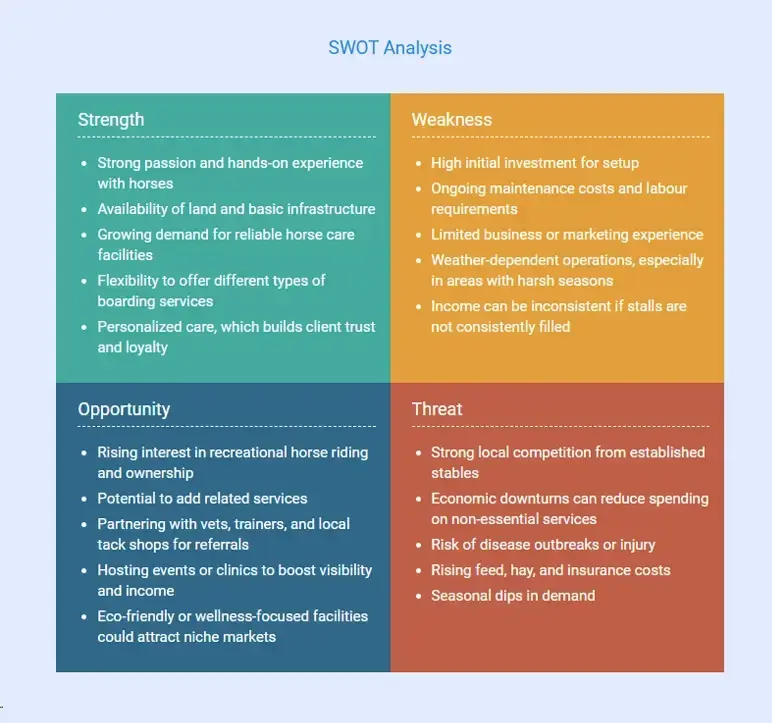
6. Marketing Strategy
A well-thought-out marketing strategy outlines how you plan to attract your target clientele and keep them coming back to your facility. With it, you can track your marketing expenses, measure what’s working, and adjust your approach over time.
Here are a few promotional methods and strategies you can consider for your horse boarding facility:
- Share high-quality photos and short videos of your stables, pastures, happy horses, and day-to-day activities.
- Connect with veterinarians, farriers, riding lessons instructors, feed stores, and tack shops, as they can become strong referral sources.
- Make sure your website is easy to navigate, mobile-friendly, and optimized for search engines.
- Ask satisfied boarders to leave reviews on platforms like Google, Yelp, or local equestrian forums.
- Provide small discounts or rewards to current clients or partners who refer new boarders. It’s a simple but effective way to grow.
Your marketing plan doesn’t need to be complex, but it should clearly show how you plan to build awareness, generate interest, and create loyal clients for your horse boarding business.
7. Operations Plan
The business operation plan explains how your horse boarding facility will run on a day-to-day basis to deliver consistent, high-quality services for horse owners.
To plan this section effectively, cover all the operational intricacies of the equestrian industry.
Begin by outlining your staffing structure and daily care workflow, and describe who’s responsible for feeding, stall cleaning, turnout, grooming, and client communication. Also, define the systems and routines you’ll use to manage daily operations.
Then, explain how you’ll handle quality assurance and performance monitoring and address how you’ll manage scalability and seasonal workload.
Finally, cover regulatory compliance and insurance. Outline how your facility will follow local zoning and animal welfare regulations, and include the types of insurance policies in place, like general liability and care, custody, and control (CCC) coverage.
A well-defined operations plan shows that your boarding facility is built to run smoothly, safely, and professionally every single day.
8. Management Team
The management section outlines who is responsible for running the horse business and why they are qualified to do so.
As a house boarding facility owner, first introduce yourself and explain your roles and responsibilities. Also, highlight the industry experience that supports your business growth.
Then, present your core team members, along with their roles, educational qualifications, and the relevant expertise they bring to the table. Further, explain how responsibilities are divided and mention who handles cleaning, feeding, and client communications.
If required, create a simple organization chart as mentioned below to highlight your hierarchical structure and how decisions are made.
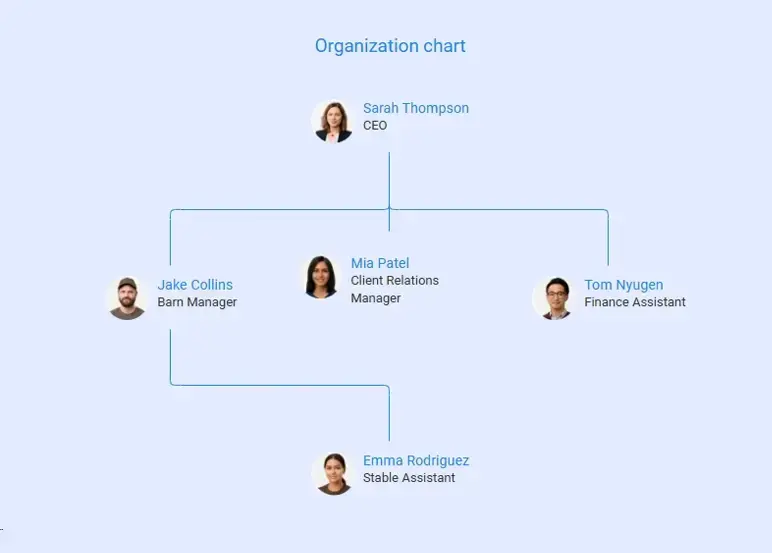
In short, a strong management team helps you gain the trust of your potential investors, as they can see that your business is in safe hands and capable of growing.
9. Financial Plan
Building a practical financial plan is one of the most important steps of your business planning, especially if you’re looking to secure funding or show long-term sustainability.
This will help you showcase the financial health and viability of your horse boarding facility to potential lenders or investors. It provides a clear picture of your revenue potential, expense structure, and how you plan to stay financially stable as your business grows.
So, while writing this section, be sure to include the following key reports and forecasts:
- Startup costs
- Revenue and sales forecast
- Projected income statements
- Projected cash flow statements
- Projected balance sheets
- Break-even analysis
- Funding request
If you want to make this section more compelling for lenders or investors, try to include simple, easy-to-understand tables or charts that break down your numbers in a clear manner.
For instance, look at the tables below for a better understanding:
Income Statement
| Line Item | Year 1 | Year 2 | Year 3 |
|---|---|---|---|
| Revenue | |||
| Boarding Fees | $108,000 | $144,000 | $180,000 |
| Additional Services | $15,000 | $20,000 | $25,000 |
| Total Revenue | $123,000 | $164,000 | $205,000 |
| Expenses | |||
| Feed & Supplies | $27,000 | $36,000 | $45,000 |
| Labour Costs | $48,000 | $55,000 | $60,000 |
| Utilities & Maintenance | $12,000 | $15,000 | $17,000 |
| Insurance & Admin | $8,000 | $8,500 | $9,000 |
| Total Expenses | $95,000 | $114,500 | $131,000 |
| Net Profit | $28,000 | $49,500 | $74,000 |
Cash Flow Statement
| Cash Flow Item | Year 1 | Year 2 | Year 3 |
|---|---|---|---|
| Cash Inflows | |||
| Cash from Operations (Revenue) | $123,000 | $164,000 | $205,000 |
| Loan or Investment Inflow | $50,000 | – | – |
| Total Inflows | $173,000 | $164,000 | $205,000 |
| Cash Outflows | |||
| Operating Expenses | $95,000 | $114,500 | $131,000 |
| Equipment & Facility Setup | $40,000 | $10,000 | $5,000 |
| Loan Repayment | $5,000 | $5,000 | $5,000 |
| Total Outflows | $140,000 | $129,500 | $141,000 |
| Net Cash Flow | $33,000 | $34,500 | $64,000 |
| Opening Cash Balance | $0 | $33,000 | $67,500 |
| Closing Cash Balance | $33,000 | $67,500 | $131,500 |
Balance Sheet
| Balance Sheet Item | Year 1 | Year 2 | Year 3 |
|---|---|---|---|
| Assets | |||
| Cash | $33,000 | $67,500 | $131,500 |
| Accounts Receivable | $3,000 | $4,000 | $5,000 |
| Equipment & Barn (net) | $45,000 | $42,000 | $40,000 |
| Land (if owned) | $50,000 | $50,000 | $50,000 |
| Total Assets | $131,000 | $163,500 | $226,500 |
| Liabilities | |||
| Accounts Payable | $2,000 | $2,500 | $3,000 |
| Loan Payable | $45,000 | $40,000 | $35,000 |
| Total Liabilities | $47,000 | $42,500 | $38,000 |
| Owner’s Equity | |||
| Owner Investment | $50,000 | $50,000 | $50,000 |
| Retained Earnings | $34,000 | $71,000 | $138,500 |
| Total Equity | $84,000 | $121,000 | $188,500 |
| Total Liabilities & Equity | $131,000 | $163,500 | $226,500 |
Download a free horse boarding business plan template
Ready to start writing your horse boarding business plan, but not sure where to begin? You’re in the right place. Download our free horse boarding business plan PDF to get started today.
This easy-to-use template will guide you through every key section of your plan—from outlining your services and understanding your target market to planning your daily operations and financials. You can also customize it to match your unique goals and facility setup.
The Quickest Way to turn a Business Idea into a Business Plan
Fill-in-the-blanks and automatic financials make it easy.
Conclusion
Now that you know how to outline your services, plan your daily operations, define your target market, and map out your finances, creating your own horse boarding business plan should feel a lot more manageable.
But if putting it all together still feels overwhelming or time-consuming, Upmetrics can help.
It’s an AI-powered business planning tool that helps you create your own business plan that’s polished and professional. It also assists you with accurate financial projections, charts, and even investor-ready pitch decks.
So, don’t wait! Get started today and turn your horse boarding vision into a real, profitable business.
